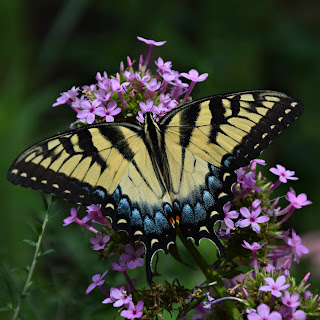We all appreciate flowers that do well in our gardens so it’s my turn to jump on the bandwagon that one particular phlox has inspired: Phlox paniculata ‘Jeana’ is a pink, small-flowered cultivar that has been around for several years but which is more recently becoming widely available. This is the second year that it has flowered in my garden.
This selection of Phlox paniculata was discovered by Jeana Prewitt along the Harpeth River in Nashville, Tennessee so it is native to the hot and humid South. This was not a bred hybrid and, by all indications, is a naturally occurring selection of the species. It also has good mildew resistance which is a generally a concern for cultivars of this species.
 |
| Eastern tiger swallowtails love 'Jeana' |
 |
| The top section of a long panicle on 'Jeana' |
 |
| Regular flower size vs. 'Jeana' |
There is much discussion lately about native plant cultivars (or “nativars” as some people call them). Are these plants good for pollinators? For me, there are two discussion points to consider first:
- Is the plant a hybrid between two species? You can recognize most hybrids by the presence of an “x” in the name or in the absence of the species name. For example, Lobelia ‘Ruby Slippers’ is a cross between the red Lobelia cardinalis and the blue Lobelia siphilitica. You will also find it documented as Lobelia x ‘Ruby Slippers’ to denote the cross.
- Or is the plant a discovery of a chance seedling or a plant with better than average qualities? If the plant was discovered in a situation (like a nursery) where it could have crossed with another species, it should be documented as noted above (with an ‘x’ or absence of species name). If it was discovered in an area where only that species was represented then it will be used with the species name (like Phlox paniculata ‘Jeana’).
In researching 'Jeana' for this post, I came upon a master’s thesis from a student at the University of Delaware. The thesis was about evaluating cultivar vs. species in Phlox sp: "CONSIDERING A ROLE FOR NATIVE PLANT CULTIVARS IN ECOLOGICAL LANDSCAPING: AN EXPERIMENT EVALUATING INSECT PREFERENCES AND NECTAR FORAGE VALUES OF PHLOX SPECIES VS. ITS CULTIVARS." The paper is worth a deeper look (and you can find it here), but ‘Jeana’ got high marks: “In comparison to Phlox paniculata, the wild-derived cultivar ‘Jeana’ was strongly preferred by nectaring invertebrates in this experiment. Insect preference for P. paniculata ‘Jeana’ is primarily attributable to the ease with which invertebrates are able to access nectar, through its comparative abundance of flowers and the narrowness and shallowness of its corolla tubes from opening to nectary.”
 |
| Carpenter bee on 'Jeana' |
I won’t be replacing all my plants with ‘Jeana,’ but I certainly might pick up another plant or two in the future. It’s nice to have such a good performer for pollinators.
By the way, one source I found noted that the plant seems to produce infertile seed so I guess we'll just have to keep buying it. 😉
The shape of the flower looks like that bee won't be able to reach the nectar. Is he cutting the sides of the flower? I guess it's perfect for the butterflies! Produces infertile seeds? If it was found in the wild... why would this be?
ReplyDelete